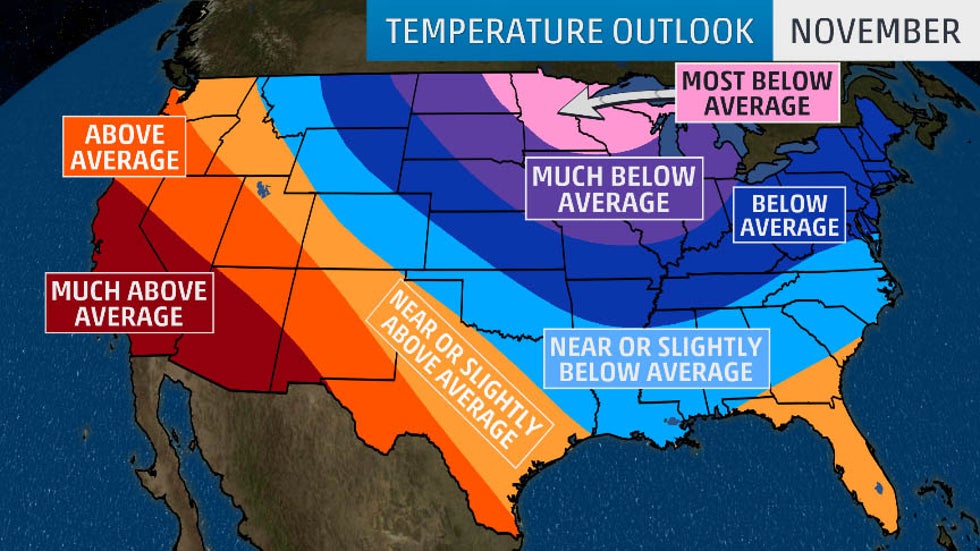November will be a cold month across the central and eastern United States as warmer than average temperatures close out autumn in the West, according to an outlook released Thursday by The Weather Company, an IBM Business.
Weather patterns in the tropics are one indicator of how temperatures might evolve in the U.S., and current conditions are similar to this time last year. These similarities are expected to continue into at least December.
Last November had unusually cold weather in most areas east of the Rockies. Medium-range computer forecast models are depicting a similar pattern to last November across the U.S. through the middle of the month.
"Given the higher confidence in a notably cold pattern in at least the first half of November, we’ve cranked up the magnitude of our negative anomalies, but have maintained the same general shape of the pattern," said Dr. Todd Crawford, chief meteorologist at The Weather Company.
The negative anomalies Crawford is referring to are below average temperatures, which are forecast to be widespread from the Northern and Central Plains eastward into the mid-South, Midwest and Northeast.

Temperatures far below average are expected in the Northern Plains, parts of the mid-Mississippi and Ohio valleys and into the southern Great Lakes.
Residents of the upper Midwest and northern Great Lakes – including portions of eastern North Dakota, Minnesota, central and northern Wisconsin and the Upper Peninsula of Michigan – will be shivering in temperatures the farthest below average in November.
On the other side of the country, above average temperatures are likely across the West and Southwest.
Areas from California into the Desert Southwest will be much above average for this time of year.
Temperatures are expected to be near, slightly above or slightly below average between the cold central and eastern U.S. and the warm West.
Average Highs in November
Average highs in November are in the 30s and 40s across the northern tier of the U.S. That means bitterly cold temperatures are likely in areas of the Northern Plains and upper Midwest that are forecast to be far below average.
Highs in the 50s are typical for November from the Pacific Northwest into the central Rockies, Central Plains, Midwest and mid-Atlantic.
November average highs are in the 60s in much of California, the Southwest, Southern Plains and Southeast. Therefore, the above average temperatures predicted in the West and Southwest will likely be warm for the final month of fall.
Average highs in the 70s are still common in November in the far southern tier of the nation.

Average Lows in November
Average lows in November are in the teens and 20s across the northern tier of the U.S. The far below average temperatures predicted in the Northern Plains and upper Midwest could potentially mean it will drop well below zero overnight.
Lows in the 30s and 40s are average for November in most other areas of the country, with 50s confined to the far southern tier. That means nights could be mild in parts of the West and Southwest, where above average temperatures are forecast.

The Weather Company’s primary journalistic mission is to report on breaking weather news, the environment and the importance of science to our lives. This story does not necessarily represent the position of our parent company, IBM.
The Weather Company’s primary journalistic mission is to report on breaking weather news, the environment and the importance of science to our lives. This story does not necessarily represent the position of our parent company, IBM.

No comments:
Post a Comment